Menus
- The good vein
- 4 cylinders in line, 998 cm3, 203 hp and 11.7 mkg at 11,400 rpm, 206 kg all full, 19,399 euros.
- Discovery
- In the saddle
- City
- Highway
- Departmental
- Circuit
- Part-cycle
- Braking
- Comfort
- Consumption
- The 2021 Kawasaki Ninja ZX-10R video test
- Conclusion
The good vein
4 cylinders in line, 998 cm3, 203 hp and 11.7 mkg at 11,400 rpm, 206 kg all full, 19,399 euros.
Who has not had their adored sportswoman, one day, on their biker journey? We all dreamed about it, we tightened our belts to pay for it, then the exhaust muffler, the tires that clear at full speed, the selfish daily life, the license points that fly…. The days are more reasonable today than those of the 1980s, when the Suz ’GSX-R was at the top of motorcycle sales in France.. The price of sports cars has since followed that of real estate in the heart of metropolises: unaffordable. In return, they give over 200 hp for just over pounds, messed up electronics and unseen handling, as well as increasingly radical driving positions. While most of them ride on the circuit, a few die-hards resist, we sometimes meet them, we envy them, we admire them ….
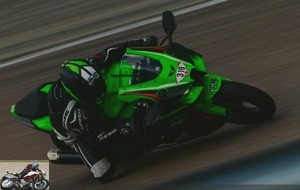 The 4 cylinder needs to be kept above 8,000 rpm to get out of bends efficiently.
The 4 cylinder needs to be kept above 8,000 rpm to get out of bends efficiently.
The Kawasaki Ninja ZX-10R 2021 is for them. Less powerful than the fiery Ducati Panigale V4, Honda CBR 1000 RR-R or BMW M 1000 RR, it follows them, even dominates them in competition, both in the French Superbike championship, with Valentin Debise, and in the same world championship. name, in the hands of the famous Jonathan Rea. Above all, it is experienced daily without a subscription (weekly …) at osteo, unlike its competitors.
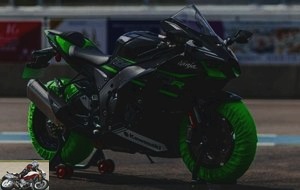 2021 Kawasaki Ninja ZX-10R review
2021 Kawasaki Ninja ZX-10R review
Discovery
The 2021 version evolves in finesse, apart from the spectacular color, taken from the multiple world champion Superbike motorcycle. The new dress induces a whole new aerodynamics, integrating winglets (aerodynamic supports, roooo, an effort), which would ensure a greater contact pressure on the front, of 17% according to Kawa. But we do not know precisely under what conditions, at what speed…. In any case, it throws, that’s probably the main thing. Changes to the rear end create a low pressure area behind the rider, which also contributes to better dynamic performance. The height of the bubble has been increased by 4 cm. The green version slams loudly, plays the game of the replica racing frankly, I prefer it to the black version; as much to fully assume sports fanaticism.
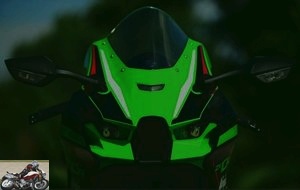 Fairing with front air intake
Fairing with front air intake
The dashboard, sometimes criticized in previous years for its needle tachometer, has become a contemporary screen, a story that is never lost. 4.3-inch TFT screen, with Bluetooth connection, the information of which can be changed on the left stalk, quite intuitively. The wallpaper adapts to the brightness, the stopwatch can be displayed in large size, the engine modes are set quickly as long as we go back to those originally planned (Sport, Road, Rain, the latter delivering only 50% of 203 hp). There are indeed Rider modes, which you select yourself the engine mode and the level of traction control (S-KTRC). However, it lacks a fuel gauge. The six-axis IMU inertial unit manages the ride by wire, therefore the throttle opening according to multiple parameters, but also the ABS (KIBS system), which cannot be disconnected on the circuit. For the competition, it will be necessary to go through the purchase of a Kawasaki kit harness, at around 3,000 euros. Kawasaki Launch Control Mode (KLCM) allows optimized starts, GP style. In contrast, the ZX-10R is equipped with cruise control, so as not to get carried away on the freeway and stay at 140 meters, or about 6500 rpm in sixth gear. Guaranteed fuel and adrenaline savings. Heated grips are optional, see if it’s a sports car that loves the road ….
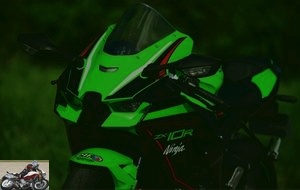 Dual LED optics
Dual LED optics
The mechanics have undergone few changes on this 2021 version. The first three gear ratios have been shortened, as well as the final reduction, which receives a crown of 41 teeth, against 39 on the old model. The radiator, previously equipped with an exchanger to cool the water and the oil, has split into two distinct parts for each of the fluids, with its own probe, therefore optimized cooling. The essentials have been preserved, with the pistons of 76 mm (against 80 mm for the Honda CBR) and the new cylinder head arrived in 2019. The racing model, the ZX-10RR (produced in 500 copies, allowing the homologation of the Superbike motorcycle), receives the same modifications, retaining its Panckl pistons and connecting rods (it develops 204 hp) and other peculiarities.
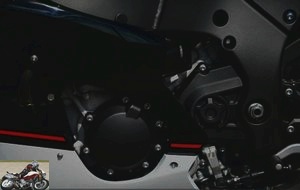 998 cm3 (76 x 55 mm)
998 cm3 (76 x 55 mm)
The chassis, finally, evolves by small touches, a major of which concerns the driving position. More sporty sitting position: the half-handlebars have been turned forward, the footrests raised by 5 mm, apparently on Jonathan Rea’s recommendations. The saddle is notched at the level of the reservoir and provides good support when braking.
The most important modifications, if they do not impress, have been for the geometry of this chassis. The swingarm took up 8mm, its pivot in the frame was lowered by 1mm, and the fork offset was increased by 2mm, all to aid stability. A new harder spring on the Showa shock absorber (which goes from 91 N / mm to 95 N / mm) and new softer springs on the fork (from 21.5 N / mm to 21.0 N / mm) ensure a better balance, once again according to the Superbike world champion.
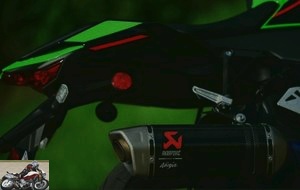 Akrapovic Ninja Exhaust
Akrapovic Ninja Exhaust
One of the complaints pointed out by many "pilots" regarding the previous ZX-10R was the fact that, despite more than 200 hp, the power was appreciated only in the upper part of the rev counter (with a maximum torque value). very high placed, above 11,000 rpm). On the road, it lacked a bit of mid-range punch. While no performance enhancement has been applied to the 2020 model (it hasn’t lost any either and is showing itself to be Euro5 compliant), Kawasaki solved this issue on the 2021 model by working on the drivetrain. Two additional teeth on the rear crown, as well as revised internal gears on the first three gears, make the 2021 Ninja much quicker in its revs. This is more of a patch than a perfect solution, but it is a gesture for the bikers that we are, without taking anything away from the trackers.
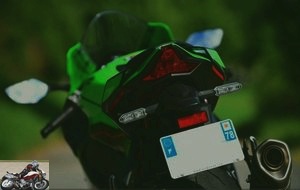 LED rear light
LED rear light
In the saddle
The position is more natural, does not require you to curl up or stretch your arms. A few small changes were enough to have the feeling of guiding the bike better, without suffering. The dashboard, readable, easy to handle, the up and down shifter effective on low and mid-range, the Kawa welcomes better than the majority of contemporary sports cars. More curious, I immediately feel, out of the Kawasaki parking lot, an ease to turn it at very low speeds, in small corners, when no modification of the chassis is supposed to improve agility. On the contrary. The tires remained the same, Bridgestone RS-11. The only explanation is the driving position. We do not insist enough on this essential parameter, which in fact categorizes motorcycles: the difference between a roadster and a sports car is the position and lack of fairing of the former. A few millimeters of rotation on half-handlebars, a centimeter on a footrest plate or a higher saddle can change everything. Don’t hesitate to adapt your motorcycles. It’s the first thing any race team worthy of the name does when it welcomes a new driver. We remember Jorge Lorenzo at Ducati…. The consequences of an unsuitable posture are more sorely felt on a demanding athlete. Ditto for the suspension settings, but the ritual takes longer.
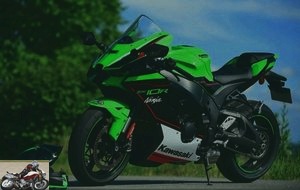 Kawasaki Ninja ZX-10R and its matching helmet
Kawasaki Ninja ZX-10R and its matching helmet
City
I was talking about megalopolises above. A lexical field that does not suit a 1000 designed for the track. The progressive motor, the gentle braking at the start of the lever then quickly powerful, the suspensions adapted to the defects of road surfaces damaged by the trucks help to better live the city aboard the ZX-10R. The well-dissipated heat is also appreciated, unlike a Ducati Panigale V4 for example, which is unbearable in hot weather. The position ends up tiring, but the Kawa sneaks in well, precise, reassuring. The duo envision themselves in troubleshooting, the pilot will make sure to be very gentle, the controls will help him. Do not hesitate to use the clutch again rather than the shifter.
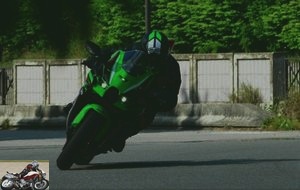 Ninja ZX-10R in town
Ninja ZX-10R in town
Highway
The immense bituminous tongue that takes us to the four corners of France does not reveal much about Kawa, except that its bubble, even raised by 4 cm, remains too low. The only reason for this choice is to look for the look, not the performance, since all official Kawasaki racing have a much higher bubble (type ZX-10R Superbike Jonathan Rea in a search engine and you will see it by yourself).
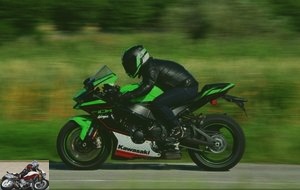 Kawasaki Ninja ZX-10R on highway
Kawasaki Ninja ZX-10R on highway
Departmental
After twenty years of testing motorcycles, I have my favorite roads, often the same ones, ideal for comparing motorcycles. From Marine, in Vexin, to Lyons-la-Forêt, on the borders of Normandy, my journey is well established. The ZX10-R surprises with its comfort of suspension, which became a guarantee of efficiency at a rapid pace. The hydraulic rebound of the shock absorber contains shock feedback, the fork, hardened by two notches in compression compared to the original, gradually sinks, the bike is still controllable, it warns, more sensitive than before. It retains its personality, a little heavy, it demands the commitment of its driver when setting the angle, but is more easy and intuitive than before. Without losing any of its superb stability, on the contrary. The front axle is magic, precise. The engine is still sluggish a little below 6,000 rpm, it becomes enthusiastic around 8,000 rpm and it is already very fast. After 200 markers of small roads, slums, fatigue is less than riding a Honda CBR or Ducati Panigale and even a more clumsy Suzuki GSX-R 1000. It seems clear to me that the ZX-10R takes precedence over all its competitors on the road. For its suspensions, its braking, its progressive motor, its homogeneity.
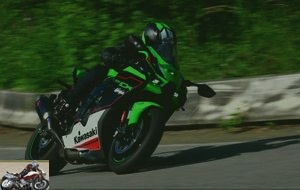 On departmental
On departmental
I then took the Kawa to go, for two weeks, to work, 40 terminals from my home, 60% highway, 20% departmental and the rest of town, it had been a long time since I had annoyed to ride so much in sports, despite the bag on the back, the traffic…. I’m not saying I would do this all year round, but the recent memory of the Honda and Ducati had vaccinated me a bit, the ZX-10R made me reconcile with the sporty genre..
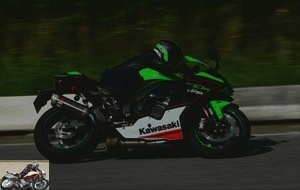 On the road
On the road
Circuit
Kawasaki has planned six driving sessions for us on the Dijon-Prenois circuit in early July, a track combining fast turns and tight sequences, ideal. The confidence felt during the first kilometers on small roads instantly returned from the first turns. I rediscovered this circuit that I had not done for ten years. The blind corners, the corner braking, the surprising drop, great terrain to put the Kawasaki to the test. Here again, the front end proved to be the best ally. Less locked in than before, it leaves more room for instinctive piloting, without compromising precision, this is the ZX-10R’s biggest strength. The agility is not yet at the level of Ducati or even BMW, the physical engagement is still important but not exhausting, thanks that the piloting becomes more evident thanks to the driving position and the stability, ensured by a wheelbase of 1450 mm.
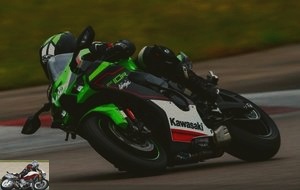 As on the road, the ZX-10R quickly builds confidence on the track
As on the road, the ZX-10R quickly builds confidence on the track
Over the laps and confident confidence, the braking, initially powerful, ends up causing a problem: the work of the ABS is felt, especially at the end of the straight line, at more than 290 km / h, before to dive into a fast right. Braking distance gets slightly longer, not great.
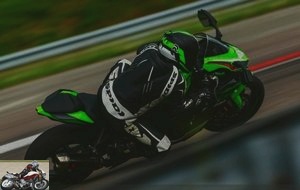 ABS tends to be felt on hard braking
ABS tends to be felt on hard braking
The engine meows delightfully between 8,000 and 14,000 rpm, thanks to the Akrapovic silencer mounted by Kawasaki France. You have to keep it within this range, otherwise the bike will struggle to get out of tight bends. We would still like him more expressive, more lively in his impulses. Before the last session, the rear Bridgestone had given everything it had, chewed well, I was then able to discover the effects of traction control, in position 1. It is released smoothly, without disturbing the balance of the motorcycle, top electronics. On the other hand, the shifter was sometimes reluctant to downshift.
 The 4 cylinder needs to be kept above 8,000 rpm to get out of bends efficiently.
The 4 cylinder needs to be kept above 8,000 rpm to get out of bends efficiently.
Here again, the too low bubble causes air movements, pressure on the shoulders. The upper body pays the price for design. Or our portfolio if we choose an adaptable ….
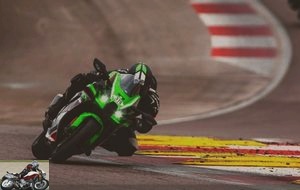 It will be necessary to invest in a higher bubble for better protection
It will be necessary to invest in a higher bubble for better protection
Part-cycle
Once again, the immense quality of the ZX-10R is revealed in the confidence it provides, the stability of its front end, the greater ease of guidance afforded by the driving position. The high quality of Showa suspensions has something to do with it too. Difficult to disturb the Kawa, even by brutalizing it. She loses a little in agility. With a few pounds less, especially on the rims (the Marchesini of the RR version must improve liveliness).
 Solo and duo comfort
Solo and duo comfort
Braking
Brembo M50 monobloc calipers, 330mm discs, a high-quality fork, all the elements were there to ensure that the braking did not lend itself to criticism. This is the case, except on the circuit, when the ABS kicks in, very discreetly but it encourages not to push the limits, unnatural for a sportswoman.
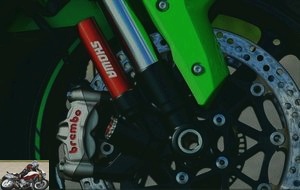 Double semi-floating 330 mm disc, 2 Brembo M50 radial calipers, 4 opposed pistons, aviation hoses
Double semi-floating 330 mm disc, 2 Brembo M50 radial calipers, 4 opposed pistons, aviation hoses
Comfort
The saddle, wide on the rear, well padded, combines with the suspensions for a pleasant comfort for a sportswoman. The riding position does not ravage the wrists, but this is neither a trail nor a road, it is all to be taken with a grain of salt. We appreciate the joys of the coffee break, peek on social networks and on and on. It does better than its competitors in terms of comfort, including GSX-R.
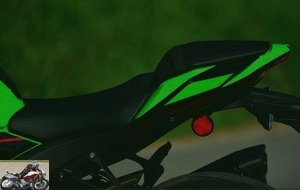 Rider seat а 835 mm
Rider seat а 835 mm
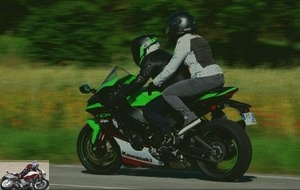 Passenger position
Passenger position
Consumption
My readings concern a mix of road, highway and city, at a varied pace but without excess, the license points cost a blind. I have never managed to go below 7 liters per 100 km, or a range of about 250 km before reserve, the tank containing 17 liters. On days of enthusiasm, I was able to go beyond 8 liters to 100 ….
 17 liter tank
17 liter tank
The 2021 Kawasaki Ninja ZX-10R video test
Conclusion
As standard, the Kawasaki ZX-10R does not outclass its competitors in terms of pure sportiness, apart from the Suzuki GSX-R 1000. The Ducati Panigale V4, the Aprilia RSV4, the Honda CBR 1000 RR, the Yamaha R1 are sharper in radicalism. Subject of course to a comparison that would highlight this statement and I cannot beg our leader, David, enough to hire him. Odious blackmail, hey hey.
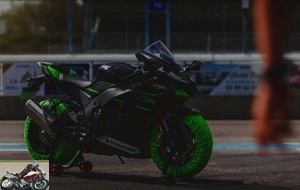 Very homogeneous, the Ninja finds the right compromise between sport and road
Very homogeneous, the Ninja finds the right compromise between sport and road
But it kicks the pawn on all these bikes, no doubt (just a little, if not no comparison ….), in terms of consistency, the perfect compromise between sport and road. It brings together all the cards for this, from the quality of the suspensions to the progressiveness of the engine, despite everything powerful, especially through the confidence that allows the chassis. Kawasaki is reconnecting with a sport that is possible to live with and capable of taking as many of us as possible on the circuit without envisioning its limits. Its standard equipment and price (high in absolute terms but reasonable compared to Honda, Ducati or Aprilia, at more than 20,000 euros) place it at the level of a Yamaha R1, a benchmark.
Strong points
- Stability
- Ease of handling
- Quality of suspensions
- Progressive motor power
Weak points
- Lack of motor sensations
- Little protective bubble
- Shifter sometimes reluctant to downshift
Kawasaki ZX-10R technical sheet
Test conditions
- Itinerary: daily and on the track
- Motorcycle mileage: – km
- Problem encountered: ras
Test equipment
- Helmet HJC RPHA 11
- Spidi Track Touring suit (circuit)
- Helstons Rocket Jacket Brown (road)
- Gloves Furygan F-RS1
- Sidi Rex Boots
Related articles
-
998 cm3, 210 hp at 13,000 rpm, 11.3 m / kg, 300 km / h, 206 kilos, € 17,799 Breathtaking performance, cutting-edge electronics, pure feel… You may not…
-
Kawasaki Ninja ZX-10R KRT motorcycle test
An integer character 4 cylinders in line, 998 cm3, 203 hp, 114.9 Nm, 206 kg all full facts, 18,099 euros. Nice surprise for me to find the Kawasaki…
-
Kawasaki ZX6 RR supersport motorcycle test
On the finger and on the eye The Kawasaki ZX-6 RR is the competition version of the ZX-6R 636 … and the basis of the model present in 600 Supersport….
-
2012 Kawasaki ER-6n motorcycle test
New test: Kawasaki ER 6N: Sparkling with mischief ! Appeared in 2006 and restyled in 2009, the ER6 N gets a new facelift that makes it even sexier,…
-
A new little sports car accessible to A2 licenses Twin cylinder in-line, 399 cm3, 45 hp at 10,000 rpm, 38 Nm at 8,000 rpm, 168 kilos, from € 5,999…
-
Kawasaki ZX10R motorcycle test
The motorcycle division of the giant Kawasaki industry, is only a drop in the sea, but that does not prevent it from being a major player in the world of…
-
Roadster with Sugomi sauce or decarenated sports car A2 licenses have the choice between large bridles, sometimes very badly bridled, and smaller ones,…
-
Revelation 998 4-cylinder compressor, 998 cm3, 200 hp, 137 Nm of torque, 239 kg, 17,099 euros The Roadster era, a heated era in the motorcycle timeline,…
-
Kawasaki Versys 650 motorcycle test
Twin-cylinder 649 cc, 69 hp, 210 kilos, A2 version, euro5 ready Daily test 2006, the year of the successive revivals of Kawasaki on segments where we…
-
Honda CBR1000RR-R Fireblade SP motorcycle test
The meaning of paradox or how to abandon Total Control for Total Taule 4 cylinders in line, 999 cm3, 217hp, 113 Nm, 201 kg all full facts, 24,999 euros…
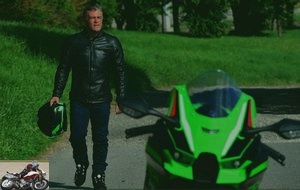
Aprilia RSV, it depends, there is the “no” Factory а 18000 and a few €, maybe more comparable.
Otherwise, in terms of consistency on road and circuit, even though it is 40hp less powerful, there is also the Ducati Panigale V2 to consider, right? I found it great on the road